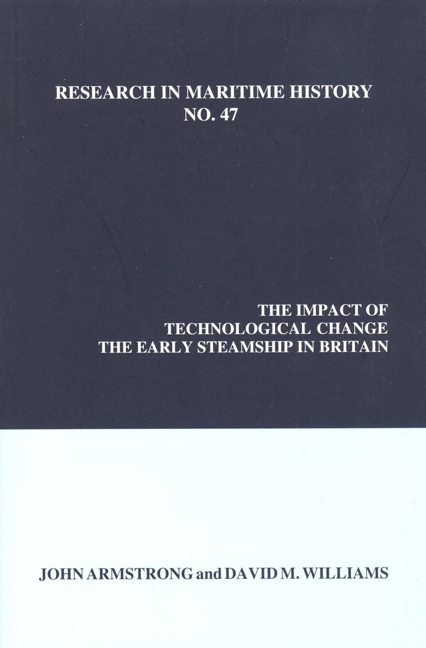Book contents
- Frontmatter
- Contents
- Series Editor's Foreword
- About the Authors
- Introduction
- Chapter 1 British Steam Navigation, 1812 to the 1850s: A Bibliographical and Historiographical Review
- Chapter 2 Some Official Listings of “Vessels Navigated by Steam” in Britain up to 1851: Evidence and Interpretation
- Chapter 3 The Steamboat, Safety and the State: Government Reaction to New Technology in a Period of Laissez-Faire
- Chapter 4 The Steamboat and Popular Tourism
- Chapter 5 The Thames and Recreation, 1815-1840
- Chapter 6 Steam Shipping and the Beginnings of Overseas Tourism: British Travel to North Western Europe, 1820-1850
- Chapter 7 Technological Advance and Innovation: The Diffusion of the Early Steamship in the United Kingdom, 1812-1834
- Chapter 8 The Steamship as an Agent of Modernisation, 1812-1840
- Chapter 9 “A New and Very Modern Business:” The Traffic and Operations of the Early Steamship
- Chapter 10 Promotion, Speculation and Their Outcome: The “Steamship Mania” of 1824-1825
- Chapter 11 The Perception and Understanding of New Technology: A Failed Attempt to Establish Transatlantic Steamship Liner Services, 1824-1828
- Chapter 12 The “Norwich Explosion” of 1817: A Local Tragedy of National Significance
- Chapter 13 Early Steamboat Services and Their Impact in North Wales, 1817-1840s
- Chapter 14 The Beginnings of a New Technology: The Constructors of Early Steamboats, 1812-1822
Chapter 9 - “A New and Very Modern Business:” The Traffic and Operations of the Early Steamship
- Frontmatter
- Contents
- Series Editor's Foreword
- About the Authors
- Introduction
- Chapter 1 British Steam Navigation, 1812 to the 1850s: A Bibliographical and Historiographical Review
- Chapter 2 Some Official Listings of “Vessels Navigated by Steam” in Britain up to 1851: Evidence and Interpretation
- Chapter 3 The Steamboat, Safety and the State: Government Reaction to New Technology in a Period of Laissez-Faire
- Chapter 4 The Steamboat and Popular Tourism
- Chapter 5 The Thames and Recreation, 1815-1840
- Chapter 6 Steam Shipping and the Beginnings of Overseas Tourism: British Travel to North Western Europe, 1820-1850
- Chapter 7 Technological Advance and Innovation: The Diffusion of the Early Steamship in the United Kingdom, 1812-1834
- Chapter 8 The Steamship as an Agent of Modernisation, 1812-1840
- Chapter 9 “A New and Very Modern Business:” The Traffic and Operations of the Early Steamship
- Chapter 10 Promotion, Speculation and Their Outcome: The “Steamship Mania” of 1824-1825
- Chapter 11 The Perception and Understanding of New Technology: A Failed Attempt to Establish Transatlantic Steamship Liner Services, 1824-1828
- Chapter 12 The “Norwich Explosion” of 1817: A Local Tragedy of National Significance
- Chapter 13 Early Steamboat Services and Their Impact in North Wales, 1817-1840s
- Chapter 14 The Beginnings of a New Technology: The Constructors of Early Steamboats, 1812-1822
Summary
In modern historiography, the steamship is accorded only modest significance during its early years. That it was confined to rivers, estuaries, coastwise and short-sea voyages is the general verdict on the steamship's progress and impact in the first thirty years of its existence following the introduction of Europe's first commercial steamship service on the Clyde in 1812. In addition, some writers have seized on the minor contribution of steam to statistics on British shipping - both in terms of numbers and total tonnage - to disparage the steamship's role before 1850. Even commentators who have been less dismissive are inclined to view the success and real impact of the steamship as occurring from the mid-nineteenth century, when longer-distance oceanic routes began to be conquered by steam.
In great measure, the debate over the success and impact of the steamship is a matter of absolute and relative judgements with an element of subjectivity influencing choice of measure and approach. We contend that the substantial penetration of river, coastal and short-sea trades by steam represented a significant element of British commerce. We also suggest that statistics of steam compared with sail in the merchant fleet are not wholly appropriate for assessing the impact of a new technology. Such varied and contrasting interpretations are not the concern of this paper, which seeks to demonstrate that whatever its relative role vis-à-vis sail or within the overall context of British shipping, the early steamship during its first three decades or so represented a new and modern business. The focus is on what the steamship offered, and delivered, in business terms. Our definition of business in this context is three-fold; business in the sense of the performance of a transport function; in the sense of traffic; and in the sense of entrepreneurial practice. Each of these will be examined in turn, but before embarking on such analysis, it may be useful to provide a sketch of the nature and progress of steam shipping in its first three decades.
- Type
- Chapter
- Information
- The Impact of Technological ChangeThe Early Steamship In Britain, pp. 183 - 204Publisher: Liverpool University PressPrint publication year: 2011



